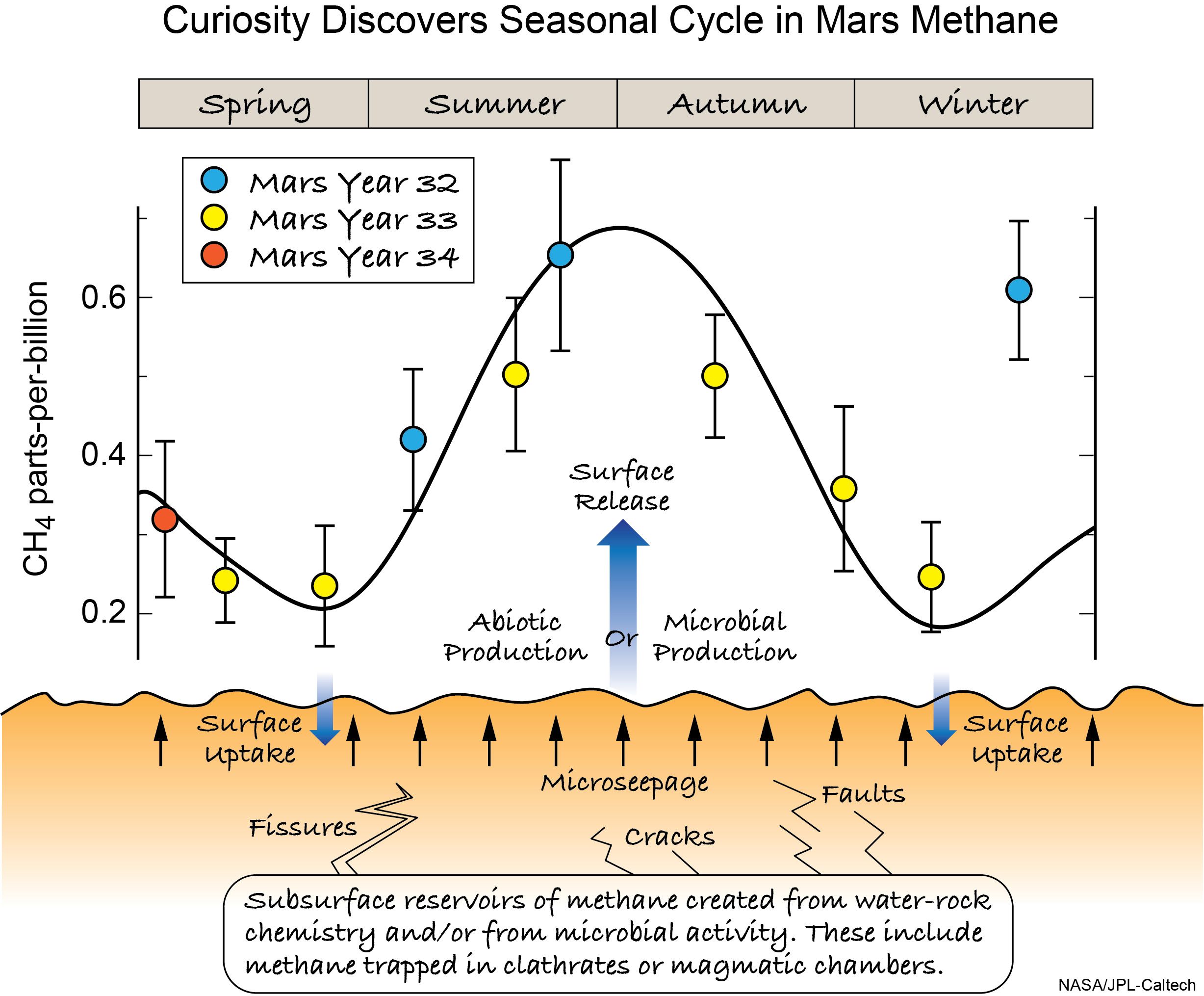
Posted on 06/07/2018 11:23:51 AM PDT by Red Badger
The robot, which has been exploring Mars for almost six years, discovered new organic compounds and cycles of methane that could point to life on Mars.
_____________________________________________________________________________
Since 2012, the Curiosity rover has been exploring Mars near a place called Mount Sharp. The robot has found chemical traces that could indicate this place was watery billions of years ago—and could have supported life. NASA can't say whether there ever was life on Mars, but new evidence reinforces the idea that Mars was habitable.
NASA's flagship Mars rover, Curiosity, has been combing the surface of Mars for signs of life for almost six years. These hints of habitability, called biosignatures, can come in many forms—from unique sediment deposits to the abundance of certain gases in the thin Martian atmosphere.
One possible biosignature on Mars—or a sign leading to potential biosigantures—is the presence of organic compounds. Almost all molecules containing carbon are organic compounds, and these molecular structures are frequently produced and consumed by living organisms. There are other ways to produce organic compounds, so they are not a smoking gun for life—but they are an awfully good sign.
And Curiosity just found an abundance of organic compounds on Mars.
Two studies (1, 2) published today in the journal Science solve past mysteries surrounding organic compounds on Mars. The first study found several new organic compounds in samples of ancient Martian mudstone that is roughly three billion years old, while the second charted seasonal fluctuations of one of the most basic organic compounds: methane.
The mudstone samples analyzed by Curiosity came from Confidence Hill and Mojave, two sites near the base of Mount Sharp in Gale crater. Curiosity drilled samples of mudstone in a region that is thought to have been a lake about three and a half billion years ago. The rover heated the Martian soil to above 500 degrees Celsius and analyzed the compounds released in the gases with its Sample Analysis at Mars (SAM) instrument. Numerous organic compounds were discovered, including thiophene, 2- and 3-methylthiophenes, methanethiol, and dimethylsulfide. The Curiosity rover preparing to conduct a drill test at Mojave on January 13, 2015. NASA/JPL-Caltech
The researchers, led by NASA biogeochemist and geologist Jennifer Eigenbrode, note that because the organic molecules differ by just one carbon sidechain, they may be fragments of larger and more complex molecules. Eigenbrode says that fact strengthens the evidence that the region in Gale crater could have been habitable in the distant past.
Eigenbrode told Popular Mechanics in an email:
"The organic matter in the ~3.5 billion-year-old lake sediments could be from life, but it is not evidence of life since non-life processes could have also created organic matter that ended up in these rocks. Meteorites and geological processes can form organic molecules and are additional possible sources for the organic matter we found. [But] even if life was not present in the ancient lake, the organics could have been food for life and thus are considered another ingredient for supporting life. The finding reinforces the idea that the ancient lake was habitable, but we don’t know if it hosted life."
Additionally, Curiosity has been conducting in-situ measurements of methane in the atmosphere for three Martian years, or 55 Earth months. Previous trace amounts of methane have been detected on Mars, but the source of the gas—which is produced in abundance by life on Earth—remained a mystery.

This illustration shows the ways in which methane from the subsurface might find its way to the surface where its uptake and release could produce a large seasonal variation in the atmosphere as observed by Curiosity.
NASA/JPL-Caltech
A team led by JPL senior research scientist Chris Webster found that the methane on Mars fluctuates with the seasons, peaking locally at 0.65 parts per billion during late summer in the Northern hemisphere and dropping to as low as 0.24 parts per billion during the other half of the Martian year.
This seasonal methane cycle suggests to the researchers that the gas may come form large deposits of water-based crystals called catharses underneath the Martian surface. Although these subterranean deposits might release and absorb methane with the seasons, the provenance of the gas is still a mystery. Methane is another organic compound that could have initially been produced or consumed by life, although it is also possible that natural geologic and chemical processes, such as erosion or delivery-by-meteorite, brought the methane to Mars as well.
From studying our own planet, we know that organic compounds are produced and consumed in abundance by life. Whether or not the organics Curiosity is finding on Mars today were produced by life in the distant past, or perhaps even feed subsurface microscopic Martians to this day, is still an unknown—but we are roving closer to the answer every sol.
His info is at https://www.donsunshine.org/
Don is a layman, but has an incredible training program (free of charge) that teaches people how to be effective disciple makers (i.e. sharing the Gospel) as a part of everyday life. Highly recommend it for anyone who really wants to obey The Great Commission.
Did 40-year-old Viking experiment discover life on Mars?
October 21, 2016 by Lisa Zyga, Phys.org feature
https://phys.org/news/2016-10-year-old-viking-life-mars.html
http://www.freerepublic.com/tag/gilbertlevin/index
http://www.freerepublic.com/tag/labeledrelease/index
Disclaimer: Opinions posted on Free Republic are those of the individual posters and do not necessarily represent the opinion of Free Republic or its management. All materials posted herein are protected by copyright law and the exemption for fair use of copyrighted works.